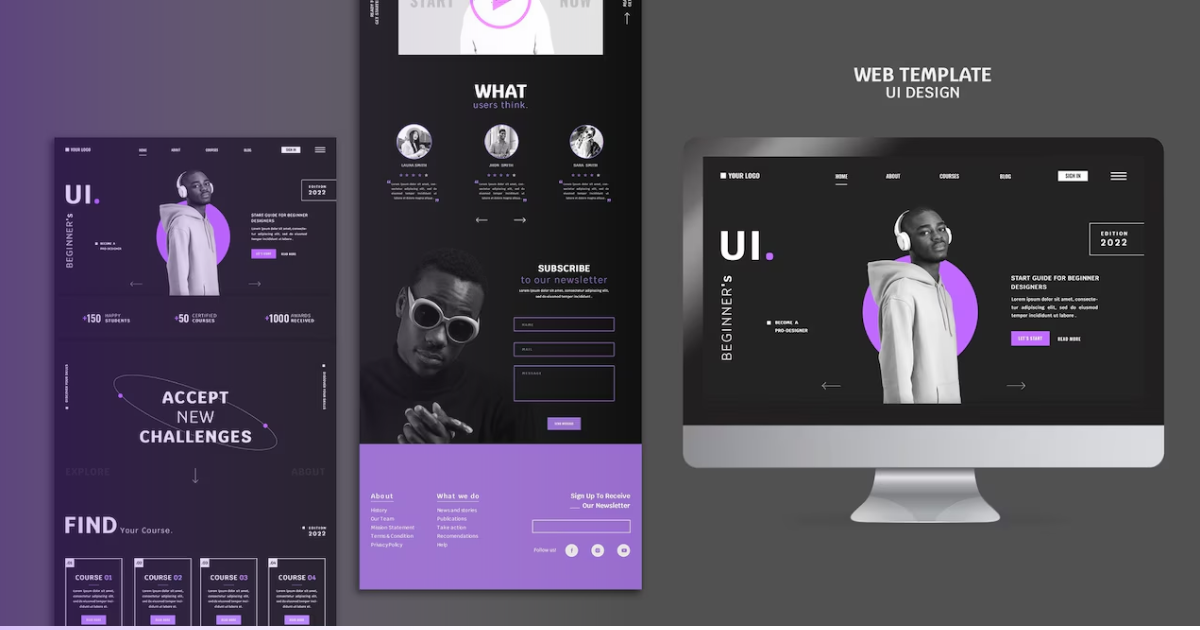How a Seo Company Klerksdorp Improves Website Design Klerksdorp Projects
Wiki Article
The Essential Components of Effective Internet Design: A Comprehensive Overview
Efficient internet Design incorporates different essential components that greatly effect customer experience. It demands careful consideration of variables such as mobile responsiveness, user-friendly navigating, and visual pecking order. Each component plays a vital role in crafting a web site that not just attracts visitors however also preserves them. Understanding these foundational facets is vital for businesses aiming to improve their online existence. Yet, what absolutely distinguishes a successful internet site from its rivals?Comprehending Individual Experience (UX) Design
Customer experience (UX) Design acts as the backbone of effective web Design, concentrating on just how customers connect with a site. It incorporates numerous components, consisting of usability, availability, and general satisfaction. A successful UX Design starts with user research study, determining the target market's behaviors and needs. Prototypes and wireframes are then developed to visualize the website's structure and circulation. Web Design South Africa. Testing with genuine individuals offers useful understandings, enabling designers to improve and refine the interface navigating. Visual Design elements, such as typography and color design, boost the total visual while sustaining performance. Ultimately, effective UX Design guarantees that customers can quickly accomplish their goals, cultivating interaction and loyalty. By prioritizing customer experience, sites can achieve higher conversion prices and a positive reputationImportance of Mobile Responsiveness
As mobile devices significantly dominate internet usage, making certain mobile responsiveness has actually ended up being vital for efficient website design. Internet sites that are not enhanced for mobile can lead to an inadequate customer experience, leading to greater bounce prices and lost possibilities. A mobile-responsive Design enables web content to adapt flawlessly to different display sizes, making certain that users can access details quickly, no matter of the device they utilize. Additionally, search engines focus on mobile-friendly websites in their positions, making responsiveness a crucial variable for presence and traffic. With a growing variety of users accessing the net via tablets and smart devices, businesses need to purchase mobile responsiveness to enhance individual involvement, improve brand assumption, and inevitably drive conversions. Effective website design must focus on mobile responsiveness to remain competitive in today's digital landscape.Crafting Intuitive Navigating
Navigating functions as the foundation of any efficient web site, leading visitors through content effortlessly. An user-friendly navigation structure enhances user experience by enabling customers to locate details promptly and effectively. Clear labeling of food selection products is important; it must show the material properly, staying clear of lingo that may confuse customers. In addition, a sensible power structure is essential, allowing users to discern partnerships in between different areas. Consistency throughout web pages assists reinforce assumptions, while breadcrumbs offer context and an orientation. Receptive navigating food selections that adapt to various gadgets even more improve ease of access. Ultimately, the goal is to produce a seamless trip for visitors, guaranteeing they can discover the site without aggravation, resulting in an extra involved and pleased target market.Using Aesthetic Power Structure
Aesthetic power structure plays a vital role in web Design by guiding customers' interest and improving their experience. Efficient layout strategies, along with thoughtful options in color and typography, can greatly affect just how info is regarded and processed. Understanding these components is necessary for creating useful and visually enticing web sites.Importance of Visual Hierarchy
Effective web Design hinges on the concept of aesthetic hierarchy, which overviews customers through material in a intuitive and rational way. This concept is crucial for boosting user experience, as it assists focus on details and routes focus to necessary elements. By establishing a clear pecking order, internet developers can guarantee that users easily recognize key messages, calls to activity, and navigating alternatives. A well-structured aesthetic power structure decreases cognitive load, enabling users to process info effectively. Furthermore, it fosters interaction by producing an attractive design that invites expedition. Inevitably, recognizing the value of aesthetic power structure is important for any internet developer intending to produce effective and easy to use internet sites that efficiently connect their designated messages.
Methods for Reliable Format
An efficient design works as the foundation of any type of successful website design, enabling customers to effortlessly browse through content. Effective methods include grid systems, which provide a structured framework for aligning components, guaranteeing consistency and balance. Additionally, making use of whitespace purposefully can boost emphasis on essential areas, lowering aesthetic clutter and guiding user attention. Prioritizing web content through size and positioning even more emphasizes crucial info, while different aspects can develop a clear visual hierarchy. Implementing receptive Design techniques guarantees layouts adapt effortlessly across tools, keeping functionality. Integrating instinctive navigation help, such as switches and menus, improves user experience, making it much easier for visitors to discover pertinent information swiftly. With each other, these strategies develop the structure of an effective web design.Shade and Typography Choices
While color and typography choices might look like easy Design aspects, they play an essential function in establishing aesthetic pecking order on a website (Website Design Klerksdorp). Color can guide users' focus, distinguish areas, and convey brand identity. By strategically making use of contrasting shades, developers can highlight important contact us to action, ensuring they stand apart. Typography, on the various other hand, affects readability and individual involvement. A well-chosen font style can communicate tone and character, while differing font dimensions and weights can develop a clear structure. As an example, bigger, bolder headings attract interest, while smaller body text offers comprehensive information. Together, reliable shade and typography options create a natural visual experience, leading individuals with the web content easily and enhancing overall usePicking the Right Color Pattern
Just how does one choose the optimal color pattern for an internet site? Picking the best color pattern is essential for enhancing individual experience and conveying the brand's message. Designers should start by considering the target market and the feelings that various colors stimulate. For instance, blue commonly symbolizes depend on, while red can develop seriousness. It is important to restrict the scheme to a couple of complementary colors to keep visual consistency and prevent frustrating individuals. Using devices like shade wheel applications can aid in picking colors that function well together. Furthermore, designers need to ensure that there suffices comparison in between message and history colors for readability. Ultimately, a well-balanced color design can greatly impact a site's efficiency and user involvement.Integrating Involving Web Content

Engaging web content is vital for keeping the focus and capturing of web site site visitors. It serves as a bridge in between the website's Design and the customer's Our site experience, promoting much deeper connections. Effective content usually includes a mix of insightful articles, charming visuals, and interactive elements that motivate customer involvement. By utilizing storytelling methods, internet sites can stimulate basics feelings, making the material extra relatable and unforgettable. In addition, incorporating user-generated content, such as evaluations or testimonials, boosts credibility and develops depend on with the target market. Clear calls-to-action guide individuals towards preferred end results, guaranteeing they stay involved. Overall, a critical technique to material growth not just boosts customer experience but also drives conversions, making it a vital facet of reliable website design.
Enhancing for Rate and Performance
Optimizing for speed and efficiency is necessary for improving customer experience on a site. Strategies such as photo compression, minifying CSS and JavaScript, and leveraging web browser caching can substantially lower loading times - Web Design Johannesburg. These strategies not just boost efficiency but also add to far better internet search engine positionsPicture Compression Methods

Minifying CSS and JavaScript
Although numerous internet designers concentrate on photo optimization, minifying CSS and JavaScript is equally essential for improving web site speed and efficiency. Minification includes getting rid of unnecessary personalities from code, such as whitespace, comments, and format, without affecting its capability. This process causes smaller documents dimensions, which causes faster filling times and improved individual experience. By lowering the quantity of information transferred between the customer and the web server, minification helps reduce bandwidth use and boosts total site effectiveness. In addition, online search engine favor quicker internet sites, which can improve search rankings. Implementing devices and automated procedures for minifying these manuscripts can improve internet development and maintenance, making certain that efficiency continues to be a priority you can try here throughout the lifecycle of a site.Leveraging Internet Browser Caching
Leveraging browser caching substantially enhances website speed and performance by keeping often accessed sources locally on a user's gadget. This method lessens the demand for repeated requests to the server, significantly minimizing loading times for returning site visitors. By using HTTP headers, web designers can specify caching rules for various sources, such as photos, scripts, and stylesheets. Correctly carried out caching approaches permit customers to experience faster web page loads, leading to enhanced user complete satisfaction and interaction. Furthermore, search engines prefer websites with optimized efficiency, potentially increasing search rankings. Consistently assessing and taking care of cache settings assures that individuals receive up-to-date web content while still gaining from the efficiency of cached resources. To conclude, reliable web browser caching is a necessary element of enhancing web efficiency.Often Asked Inquiries
Exactly how Do I Select the Right Internet Design Tools?

Choosing the appropriate website design devices involves evaluating task requirements, recognizing user requirements, and evaluating numerous software application attributes. Compatibility, simplicity of use, and area support are likewise essential variables to take into account for reliable Design end results.
What Prevail Web Design Errors to Stay Clear Of?
Usual website design errors to prevent consist of messy layouts, inadequate navigation, poor mobile responsiveness, sluggish filling times, and overlooking customer experience. Effective layouts focus on ease of access, performance, and simplicity to engage customers and boost satisfaction.How Can I Determine My Web site's Success?
To gauge an internet site's success, one might analyze metrics such as web traffic, conversion rates, user engagement, and bounce rates. Using tools like Google Analytics can supply useful understandings for ongoing optimization and renovation strategies.What Duty Does SEO Play in Website Design?
Search engine optimization substantially influences internet Design by making sure that web sites are structured for internet search engine presence. This consists of maximizing site speed, mobile responsiveness, and material top quality, inevitably boosting individual experience and driving organic traffic.How Frequently Should I Update My Internet Site Design?
The regularity of web site Design updates depends on industry patterns, individual comments, and technological innovations. Normally, a refresh every 2-3 years is a good idea, making certain the site remains pertinent and aligned with current standards and customer expectations.Individual experience (UX) Design serves as the foundation of effective internet Design, concentrating on how customers engage with a site. With a growing number of customers accessing the internet using tablets and smartphones, services should invest in mobile responsiveness to boost user interaction, boost brand name perception, and inevitably drive conversions. An intuitive navigation framework improves customer experience by allowing individuals to locate info promptly and efficiently. Appropriately applied caching methods allow individuals to experience faster web page loads, resulting in boosted user contentment and engagement. The frequency of website Design updates depends on market fads, customer comments, and technical improvements.
Report this wiki page